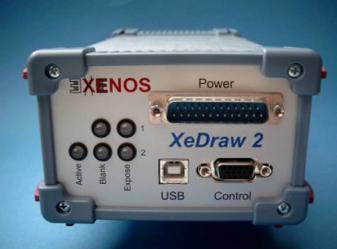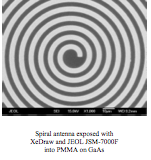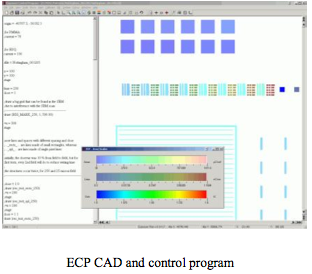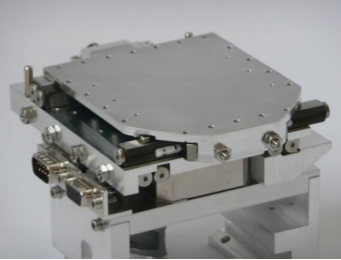Xenos Pattern Generator

XENOS patter generators: convert your SEM into a nanolithography tool! Get a writing speed up to 50 MHz. The hardware comes with data preparation software and may include a beam blanker and a precision stage.
Attached onto your existing or to be SEM or FIB, the XeDraw 2 writer system will turn it into a state-of-the-art nanolithography-tool. Enjoy 4 essential advantages:
Writing speed
Pixelrates up to 10 MHz can be realized with the XeDraw 2 system and 50 MHz with Xenos XPG. Thanks to intelligent writing algorithms, the limited deflection bandwidth of current FIBs or SEMs is taken into account. Optimized data transmission via USB and settling time calculation are matched to the writing speed in order to provide all advantages of fast writing.
Intelligent and versatile writing primitives
In competing systems, curved structures like circles, rings or ellipsoids will be written by a polygonial approximation of the structures. Arising problems are due either to poor approximation or huge amounts of data that have to be processed and that often result in undesirable blanking between the polygonial parts of the structures.

The XeDraw 2 implements a polynomial scan logic of 3rd order that can generate and write those polynomials and thus improved in comparison with our competitors. Circles, rings or ellipsoids can therefore be written by concentrical single pixel rings (with spline interpolation). Thus, maximum writing speed and approximation quality can be achieved with minimum data overhead and transmission time. Moreover, the sinusoidal shape of the deflection signals consumes much less deflection bandwidth than raster scanning of polygonial parts of the structures. Furthermore, the XeDraw 2 writing algorithm symmetrically uses the bandwidth of X- and Y- axis.
Extreme flexibility
The system can be configured to suit your needs perfectly. The DSP kernel will be booted at startup via the USB link, therefore kernel updates are merely a cut and paste operation on the controlling PC. Special features like Focussed Electron Beam Induced Processing (FEBIP) or writing strategy control for FIB processing are implemented.
Latest digital electronics, user friendly software and first class accessories

The complete deflection signal generation is implemented in a fast digital signal processor (DSP) with 16/32 bit per axis. Especially the field correction does not use bandwidth limiting multiplying analog DACs, but is built fully digitally, working up to maximum writing speed without any distortions in the resulting deflection signal.
The exposure dwell time is generated linearily with sub nanosecond resolution.
Our CAD and control software ECP has been written by experienced lithography users. This makes ECP a user friendly and lithography user specific system. ECP is available either based on Linux or Windows, and the CAD part can be used at liberty within the workgroup.
XeMove Stage
The XENOS XeMove stages use state-of-art laser measurement systems and ultrasonic piezo drive technology to obtain stitching and overlay accuracies better than 100 nm in combination with our lithography systems (measurement resolution of 10 nm).

The compact design allows the use as either substage or replacement stage, with only electrical chamber feedthroughs needed. All components are high-vacuum compatible and completely non-ferromagnetic. The compact design comprises both the laser measurement system and the piezo drive components. On- axis measurement reduces the effects of yaw-errors to a minimum. Travel ranges are available from 55 mm up to 120 mm.
Integration into existing systems does not require complicated and expensive chamber modifications. No laser viewports for the measurement system or mechanical feedthroughs for the stage motors are needed, all active components are placed within the vacuum chamber and controlled electronically via standard electrical feedthroughs. For some chamber designs (e.g. JEOL JSM-7xxx), the stage can be inserted via the loadlock and connected by special electrical ZIF-contacts within the chamber. The driving motors are powered down when the stage has stopped, the position is locked mechanically, thus overall power consumption is reduced to a minimum, preventing heating up and associated drift.
The stage is controlled via USB interface, a desktop unit allows manual control of stage parameters and movement control via joystick. The same desktop unit controls the XENOS fast electrostatic beam blanker if fitted to the litho system.
XeSwitch Beam Blanker
The XENOS XeSwitch beam blanker uses electrostatic blanking plates and a high speed high voltage blanking amplifier to allow fast beam blanking for lithography or other applications.
As well, it is equipped with a Faraday cup and picoamperemeter to allow precise beam current measurements directly at the beam within the electron optical column.

The blanker head with blanking plates is positioned at the beam axes by a piezo drive within the vacuum chamber of the blanker, thus no mechanical feedtroughs to the vacuum of the column are needed.
With the ability to position the blanker at either the blanking or Faraday cup position, it is as well possible to fully retract the blanker from the beam axes in order to provide zero beam influence during observation mode.
Integration into existing systems does not require any complicated and expensive column modification. The blanker fits into almost any JEOL or Hitachi SEM equipped with a PCD port.
The blanker can be controlled via USB interface, a desktop unit allows manual control of blanker-head position and operating parameters. The same desktop unit can control the XENOS XeMove lithography stage if fitted to the litho system.
